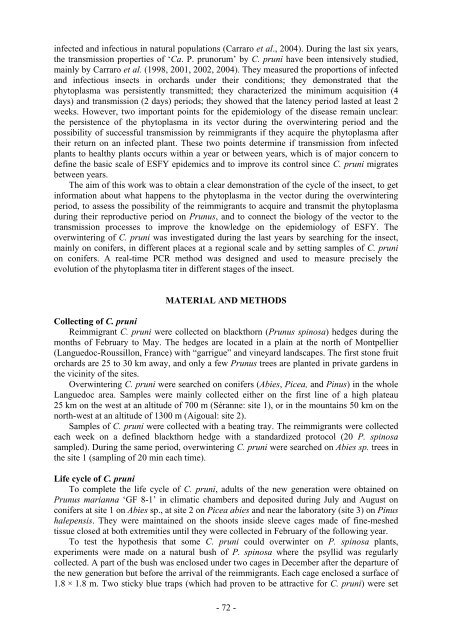Ecole Nationale Supérieure Agronomique de Montpellier ... - CIAM
Ecole Nationale Supérieure Agronomique de Montpellier ... - CIAM
Ecole Nationale Supérieure Agronomique de Montpellier ... - CIAM
Create successful ePaper yourself
Turn your PDF publications into a flip-book with our unique Google optimized e-Paper software.
infected and infectious in natural populations (Carraro et al., 2004). During the last six years,<br />
the transmission properties of ‘Ca. P. prunorum’ by C. pruni have been intensively studied,<br />
mainly by Carraro et al. (1998, 2001, 2002, 2004). They measured the proportions of infected<br />
and infectious insects in orchards un<strong>de</strong>r their conditions; they <strong>de</strong>monstrated that the<br />
phytoplasma was persistently transmitted; they characterized the minimum acquisition (4<br />
days) and transmission (2 days) periods; they showed that the latency period lasted at least 2<br />
weeks. However, two important points for the epi<strong>de</strong>miology of the disease remain unclear:<br />
the persistence of the phytoplasma in its vector during the overwintering period and the<br />
possibility of successful transmission by reimmigrants if they acquire the phytoplasma after<br />
their return on an infected plant. These two points <strong>de</strong>termine if transmission from infected<br />
plants to healthy plants occurs within a year or between years, which is of major concern to<br />
<strong>de</strong>fine the basic scale of ESFY epi<strong>de</strong>mics and to improve its control since C. pruni migrates<br />
between years.<br />
The aim of this work was to obtain a clear <strong>de</strong>monstration of the cycle of the insect, to get<br />
information about what happens to the phytoplasma in the vector during the overwintering<br />
period, to assess the possibility of the reimmigrants to acquire and transmit the phytoplasma<br />
during their reproductive period on Prunus, and to connect the biology of the vector to the<br />
transmission processes to improve the knowledge on the epi<strong>de</strong>miology of ESFY. The<br />
overwintering of C. pruni was investigated during the last years by searching for the insect,<br />
mainly on conifers, in different places at a regional scale and by setting samples of C. pruni<br />
on conifers. A real-time PCR method was <strong>de</strong>signed and used to measure precisely the<br />
evolution of the phytoplasma titer in different stages of the insect.<br />
MATERIAL AND METHODS<br />
Collecting of C. pruni<br />
Reimmigrant C. pruni were collected on blackthorn (Prunus spinosa) hedges during the<br />
months of February to May. The hedges are located in a plain at the north of <strong>Montpellier</strong><br />
(Languedoc-Roussillon, France) with “garrigue” and vineyard landscapes. The first stone fruit<br />
orchards are 25 to 30 km away, and only a few Prunus trees are planted in private gar<strong>de</strong>ns in<br />
the vicinity of the sites.<br />
Overwintering C. pruni were searched on conifers (Abies, Picea, and Pinus) in the whole<br />
Languedoc area. Samples were mainly collected either on the first line of a high plateau<br />
25 km on the west at an altitu<strong>de</strong> of 700 m (Séranne: site 1), or in the mountains 50 km on the<br />
north-west at an altitu<strong>de</strong> of 1300 m (Aigoual: site 2).<br />
Samples of C. pruni were collected with a beating tray. The reimmigrants were collected<br />
each week on a <strong>de</strong>fined blackthorn hedge with a standardized protocol (20 P. spinosa<br />
sampled). During the same period, overwintering C. pruni were searched on Abies sp. trees in<br />
the site 1 (sampling of 20 min each time).<br />
Life cycle of C. pruni<br />
To complete the life cycle of C. pruni, adults of the new generation were obtained on<br />
Prunus marianna ‘GF 8-1’ in climatic chambers and <strong>de</strong>posited during July and August on<br />
conifers at site 1 on Abies sp., at site 2 on Picea abies and near the laboratory (site 3) on Pinus<br />
halepensis. They were maintained on the shoots insi<strong>de</strong> sleeve cages ma<strong>de</strong> of fine-meshed<br />
tissue closed at both extremities until they were collected in February of the following year.<br />
To test the hypothesis that some C. pruni could overwinter on P. spinosa plants,<br />
experiments were ma<strong>de</strong> on a natural bush of P. spinosa where the psyllid was regularly<br />
collected. A part of the bush was enclosed un<strong>de</strong>r two cages in December after the <strong>de</strong>parture of<br />
the new generation but before the arrival of the reimmigrants. Each cage enclosed a surface of<br />
1.8 × 1.8 m. Two sticky blue traps (which had proven to be attractive for C. pruni) were set<br />
- 72 -



